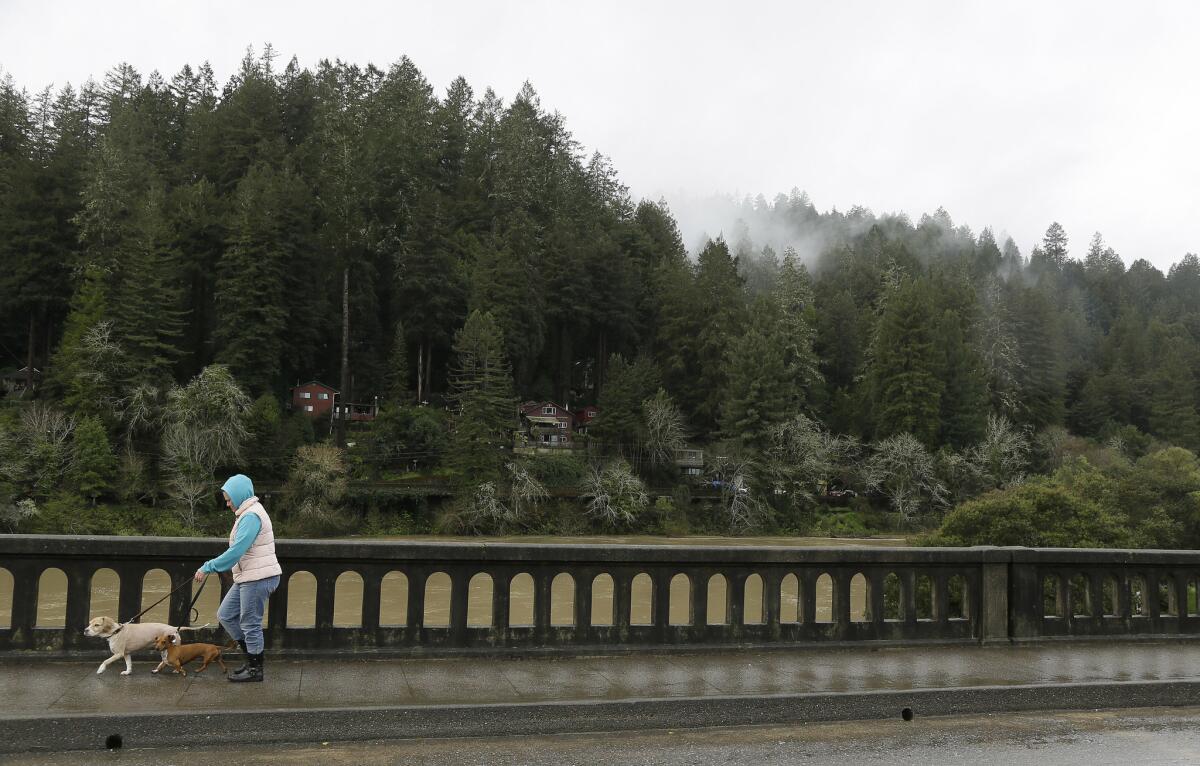Drenched by ‘March Miracle,’ Northern California reservoirs inch toward capacity

A woman walks her dog over the rising Russian River on Friday in Monte Rio, Calif.
- Share via
A series of storms pushed California’s biggest reservoir past its historical average for mid-March this weekend and put the second largest one on track for doing the same by Monday afternoon, officials said.
Together the Lake Shasta and Lake Oroville reservoirs have the capacity to hold more than 8 million acre feet of water and after a wet weekend in Northern California, they were 79% and 70% full, respectively, by Monday morning, according to the state Department of Water Resources.
Some people have referred to the recent series of powerful storms that have dumped rain and snow on the Sierra as the “March Miracle.”
Water and Power is The Times’ guide to the drought. Sign up to get the free newsletter >>
The storms filled Lake Shasta above its average for this time of year and by 4 p.m. Monday, Lake Oroville surpassed its historic average, said DWR spokesman Doug Carlson. Lake Shasta is the state’s largest reservoir.
“It’s happened a little quicker than I personally thought,” Carlson said. “It would appear the [seasonal storms] have really achieved what they historically do, which is deliver a lot of rainfall to the mountains.”
Neither reservoir has reached its historical average in nearly three years, data show.
“I don’t know if people here will be dancing in their cubicles when [Oroville] hits the historic average, but it will be the first time it’s done that for the duration of the drought. That is reason to be joyous,” Carlson said.
According to the National Weather Service, it rained nearly a foot in El Dorado County and more than nine inches in Shasta County between Friday and Monday mornings. Since March 1, the Shasta reservoir has received more than 16 inches of rain.
On March 6, Lake Oroville saw its biggest single-day rise in 12 years, DWR reported.
If the soggy month continues, both reservoirs could actually fill to the brim by April, officials say. Neither reservoir has been full since about the beginning of the drought, officials said.
The Shasta reservoir would need about 1 million acre feet more of rain to hit its capacity.
“It’s possible that it could fill if the wet pattern continues…it’s on track to at least get to average storage” for that time of year, said Shane Hunt, a spokesman with the federal Bureau of Reclamation, which monitors the Shasta reservoir.
After four years of drought, even hitting a 15-year historical average for a reservoir in California is a sign of progress, experts say.
“It’s definitely a step in the right direction, but it’s not a panacea. We’re not saved,” Hunt said. “We dug a pretty big hole in a lot of spots.”
Other reservoirs across the state are also doing well. The once-anemic Lake Folsom is now at 116% of historical average for the date and at 69% of total capacity.
For breaking California news, follow @JosephSerna.
Hoy: Léa esta historia en español
ALSO
Orange County beaches reopen after surfer reports shark encounter
Man who stole West Covina police cruiser shot dead after police chase
UC Berkeley assistant basketball coach is out amid sexual harassment allegations
More to Read
Sign up for Essential California
The most important California stories and recommendations in your inbox every morning.
You may occasionally receive promotional content from the Los Angeles Times.










